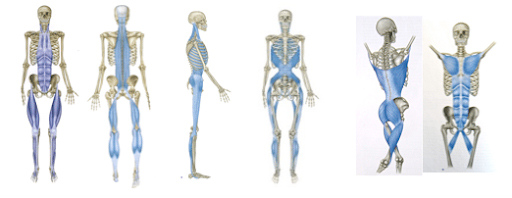Treating Myofascial Trigger Points
You’ve probably heard of trigger points. These are also known as “knotted muscles”. Trigger points are adhesions in the connective tissue. These adhesions are fascia. Fascia has become a hot topic in fitness and healthcare in recent years. After all, It has inspired many products such as foam rollers, and using tennis and lacrosse balls for more than just sports. You might be wondering though, “What is fascia, and what do these techniques actually do?”
What is Fascia?
Fascia was once considered a simple network of tissue that holds our organs in place. Now, we know what a large role it has in maintaining static posture. As a matter of fact, it also plays a large role in dynamic movement quality and efficiency, along with energy transfer throughout the body.
There are different layers of fascia, each having its own impact on our function. Firstly, the superficial layer of fascia is where adhesions occur, meaning the fascial layers become stuck and have difficulty sliding and gliding. Secondly, the deeper layer responds by becoming more tense or rigid based on the way your movements stress it. This tissue response supports the idea of including multi-directional movements to your training or workouts. If you only move in one plane, not only do the other muscles atrophy and weaken, but the fascial complex loses its ability to maintain efficiency.
Fascial Chains
There are six major chains of fascia: superficial posterior, superficial anterior, deep anterior, lateral, spiral, and upper extremity. Energy transmits through these chains continuously like a railroad track. For example, you’d think taking a step would be caused by moving your foot forward, right? Actually, the movement is initiated at your opposite shoulder and then transmitted diagonally through a specific fascial train to help propel you forward.

How Does Fascia Affect Movement and Function?
There are different types of sensory receptors within the fibers of the deep myofascial chains that all serve to transmit sensory information to the brain. Some of these receptors have an impact on the resting tone of the muscle. Meaning how much force is being produced in a resting state.
When the neurological signal becomes dysfunctional, it can cause an increase in tone in part of the fiber and shorten the related fascia. This dysfunctional signal can produce “trigger points” or taut bands in the muscle. These bands may result in fascial adhesions and pain. Some of the other receptors act to provide feedback about joint position and dysfunctions such as overstretch, rupture, and imbalance. This signal can cause a pain response in the tissues surrounding the joint. Research has also found that when these fascial networks are disrupted via injury, the feedback is less efficient. This causes further damage to the joint itself. This can have long-lasting effects, such as chronic ankle instability. This happens when the tissues are repetitively stressed beyond their limit.
What is Trigger Point Therapy?
Because fascia is not an elastic tissue like muscle and tendons, the amount of deformation when a stretch is applied is minimal. The adhesions occurring between fascia and the underlying tissues, or the fascial fibers themselves, are the primary cause of dysfunction. Physical therapy is important in locating, understanding, and treating trigger points. The goal of treatment is to target and address these adhesions.
Conditions that Trigger Point Therapy Can Help Treat
Because the fascia tissue network is so widespread, a wide range of conditions can benefit from trigger point therapy:
- Headaches
- Neck pain
- Shoulder pain
- Hip pain
- Low back pain
- Carpal tunnel and other repetitive work injuries
- And many more
Fascial Pain and Trigger Point Therapy Treatments
Myofascial Release: Myofascial Release (MFR) is a manual technique that requires the use of the hands to detect areas of fascial adhesion. Once detected, your physical therapist will apply light pressure to stretch the tissue.
Dry Needling: Trigger point dry needling is a technique that utilizes thin solid filament needles. These needles insert into a taut band, called an active trigger point. This causes increased blood flow and a release of several chemical responses. These decrease pain and return the tissue to a functional state.
IASTM: Instrument-Assisted Soft Tissue Mobilization utilizes similar principles of MFR. This technique involves combing the fascia with a tool to identify areas of restriction or adhesion. Once identified, the therapist uses the tools to break up these adhesions using a cross-frictional pattern.
What is a Trigger Point Therapy Session Usually Like?
Your physical therapist will conduct an initial movement assessment to determine where the pain, discomfort, and range-of-motion limitations exist. Your treatment plan might include any of the treatments listed above. Examples include massaging the trigger point area or areas, as well as any strength-building exercises your therapist recommends. Click here to schedule an appointment to see us today!
